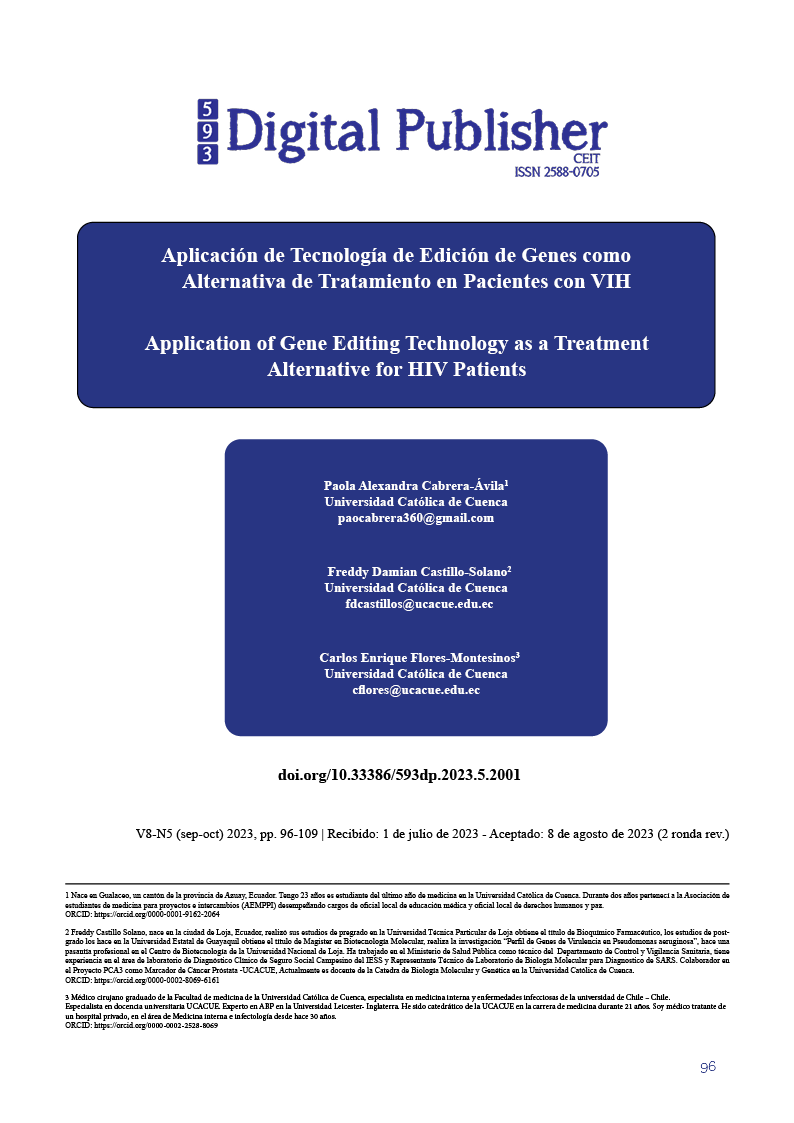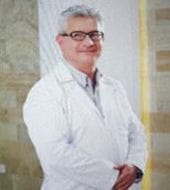Application of Gene Editing Technology as a Treatment Alternative for HIV Patients
Main Article Content
Abstract
Human immunodeficiency virus (HIV) is characterized by progressively damaging the immune system, which is why therapeutic methods have been developed over the years to alleviate the symptoms presented by patients. However, these methods do not eradicate the disease. Gene therapy is a promising alternative when it comes to virus eradication, as it proposes gene editing to eliminate the virus from the cell.
Currently, new therapeutic strategies are being explored, such as the use of gene editing technology, to reduce viral replication and eliminate HIV from the human genome.
Improving adherence to antiretroviral treatment (ART) is important, and the impact of side effects on adherence is being reviewed. Knowledge about ART can moderate the relationship between side effects and adherence.
In general, the findings of this review suggest that continuous research is necessary to find alternative HIV treatments and improve the quality of life for people living with this disease. The new therapeutic strategies show promise, but further studies are needed to evaluate their safety and efficacy. Improving adherence to ART remains a significant challenge, and effective interventions are needed to enhance adherence and prevent drug resistance.
In conclusion, the findings suggest that gene therapies have great potential to improve the quality of life for people living with HIV/AIDS and enhance the effectiveness of antiretroviral treatment.
Downloads
Article Details

This work is licensed under a Creative Commons Attribution-NonCommercial-ShareAlike 4.0 International License.
1. Derechos de autor
Las obras que se publican en 593 Digital Publisher CEIT están sujetas a los siguientes términos:
1.1. 593 Digital Publisher CEIT, conserva los derechos patrimoniales (copyright) de las obras publicadas, favorece y permite la reutilización de las mismas bajo la licencia Licencia Creative Commons 4.0 de Reconocimiento-NoComercial-CompartirIgual 4.0, por lo cual se pueden copiar, usar, difundir, transmitir y exponer públicamente, siempre que:
1.1.a. Se cite la autoría y fuente original de su publicación (revista, editorial, URL).
1.1.b. No se usen para fines comerciales u onerosos.
1.1.c. Se mencione la existencia y especificaciones de esta licencia de uso.
References
Arts, E. J., & Hazuda, D. J. (2012). HIV-1 antiretroviral drug therapy. Cold Spring Harbor Perspectives in Medicine, 2(4). https://doi.org/10.1101/CSHPERSPECT.A007161
Ayala-Suárez, R., Díez-Fuertes, F., Calonge, E., Tarazona, H. E. D. L. T., de Alda, M. G. R., Capa, L., & Alcamí, J. (2020). Insight in miRNome of Long-Term Non-Progressors and Elite Controllers Exposes Potential RNAi Role in Restraining HIV-1 Infection. Journal of Clinical Medicine, 9(8), 1–20. https://doi.org/10.3390/JCM9082452
Baltimore, D. (1988). Intracellular immunization. Nature 1988 335:6189, 335(6189), 395–396. https://doi.org/10.1038/335395a0
Bobbin, M. L., Burnett, J. C., & Rossi, J. J. (2015). RNA interference approaches for treatment of HIV-1 infection. Genome Medicine, 7(1). https://doi.org/10.1186/S13073-015-0174-Y
Can Gene Therapy Cure AIDS? | Science | AAAS. (n.d.). Retrieved December 6, 2022, from https://www.science.org/content/article/can-gene-therapy-cure-aids
Cary, D. C., Fujinaga, K., & Peterlin, B. M. (2016). Molecular mechanisms of HIV latency. The Journal of Clinical Investigation, 126(2), 448. https://doi.org/10.1172/JCI80565
Castro-Gonzalez, S., Colomer-Lluch, M., & Serra-Moreno, R. (2018). Barriers for HIV Cure: The Latent Reservoir. AIDS Research and Human Retroviruses, 34(9), 739–759. https://doi.org/10.1089/AID.2018.0118
Chao, T. C., Zhang, Q., Li, Z., Tiwari, S. K., Qin, Y., Yau, E., Sanchez, A., Singh, G., Chang, K., Kaul, M., Karris, M. A. Y., & Ranaa, T. M. (2019a). The Long Noncoding RNA HEAL Regulates HIV-1 Replication through Epigenetic Regulation of the HIV-1 Promoter. MBio, 10(5). https://doi.org/10.1128/MBIO.02016-19
Chao, T. C., Zhang, Q., Li, Z., Tiwari, S. K., Qin, Y., Yau, E., Sanchez, A., Singh, G., Chang, K., Kaul, M., Karris, M. A. Y., & Ranaa, T. M. (2019b). The Long Noncoding RNA HEAL Regulates HIV-1 Replication through Epigenetic Regulation of the HIV-1 Promoter. MBio, 10(5). https://doi.org/10.1128/MBIO.02016-19
Chattong, S., Chaikomon, K., Chaiya, T., Tangkosakul, T., Palavutitotai, N., Anusornvongchai, T., & Manotham, K. (2018). Efficient ZFN-Mediated Stop Codon Integration into the CCR5 Locus in Hematopoietic Stem Cells: A Possible Source for Intrabone Marrow Cell Transplantation. AIDS Research and Human Retroviruses, 34(7), 575–579. https://doi.org/10.1089/AID.2018.0007
Choi, J. G., Bharaj, P., Abraham, S., Ma, H., Yi, G., Ye, C., Dang, Y., Manjunath, N., Wu, H., & Shankar, P. (2015). Multiplexing seven miRNA-Based shRNAs to suppress HIV replication. Molecular Therapy : The Journal of the American Society of Gene Therapy, 23(2), 310–320. https://doi.org/10.1038/MT.2014.205
Chun, T. W., Moir, S., & Fauci, A. S. (2015). HIV reservoirs as obstacles and opportunities for an HIV cure. Nature Immunology, 16(6), 584–589. https://doi.org/10.1038/NI.3152
Cox, D. B. T., Platt, R. J., & Zhang, F. (2015). Therapeutic genome editing: prospects and challenges. Nature Medicine 2015 21:2, 21(2), 121–131. https://doi.org/10.1038/nm.3793
Dai, W., Wu, F., McMyn, N., Song, B., Walker-Sperling, V. E., Varriale, J., Zhang, H., Barouch, D. H., Siliciano, J. D., Li, W., & Siliciano, R. F. (2022). Genome-wide CRISPR screens identify combinations of candidate latency reversing agents for targeting the latent HIV-1 reservoir. Science Translational Medicine, 14(667), eabh3351. https://doi.org/10.1126/SCITRANSLMED.ABH3351
Douek, D. C. (2018). HIV Infection: Advances Toward a Cure. Topics in Antiviral Medicine, 25(4), 121. /pmc/articles/PMC5935215/
Ecuador | ONUSIDA. (n.d.). Retrieved November 11, 2022, from https://www.unaids.org/es/regionscountries/countries/ecuador
Gaj, T., Staahl, B. T., Rodrigues, G. M. C., Limsirichai, P., Ekman, F. K., Doudna, J. A., & Schaffer, D. V. (2017). Targeted gene knock-in by homology-directed genome editing using Cas9 ribonucleoprotein and AAV donor delivery. Nucleic Acids Research, 45(11). https://doi.org/10.1093/NAR/GKX154
Gonçalves, G. A. R., & Paiva, R. de M. A. (2017). Gene therapy: advances, challenges and perspectives. Einstein (São Paulo), 15(3), 369–375. https://doi.org/10.1590/S1679-45082017RB4024
HIV. (n.d.). Retrieved November 11, 2022, from https://www.who.int/data/gho/data/themes/hiv-aids
Ji, H., Lu, P., Liu, B., Qu, X., Wang, Y., Jiang, Z., Yang, X., Zhong, Y., Yang, H., Pan, H., Zhao, L., Xu, J., Lu, H., & Zhu, H. (2018). Zinc-Finger Nucleases Induced by HIV-1 Tat Excise HIV-1 from the Host Genome in Infected and Latently Infected Cells. Molecular Therapy. Nucleic Acids, 12, 67–74. https://doi.org/10.1016/J.OMTN.2018.04.014
Khan, S., Ullah, M. W., Siddique, R., Nabi, G., Manan, S., Yousaf, M., & Hou, H. (2016). Role of recombinant DNA technology to improve life. International Journal of Genomics, 2016. https://doi.org/10.1155/2016/2405954
Kong, W., Biswas, A., Zhou, D., Fiches, G., Fujinaga, K., Santoso, N., & Zhu, J. (2020). Nucleolar protein NOP2/NSUN1 suppresses HIV-1 transcription and promotes viral latency by competing with Tat for TAR binding and methylation. PLoS Pathogens, 16(3). https://doi.org/10.1371/JOURNAL.PPAT.1008430
Kwarteng, A., Ahuno, S. T., & Kwakye-Nuako, G. (2017). The therapeutic landscape of HIV-1 via genome editing. AIDS Research and Therapy 2017 14:1, 14(1), 1–16. https://doi.org/10.1186/S12981-017-0157-8
La OPS/OMS y ONUSIDA instan a poner fin a las desigualdades para eliminar el sida - OPS/OMS | Organización Panamericana de la Salud. (n.d.). Retrieved November 13, 2022, from https://www.paho.org/es/noticias/30-11-2021-opsoms-onusida-instan-poner-fin-desigualdades-para-eliminar-sida
Liu, X., Wang, M., Qin, Y., Shi, X., Cong, P., Chen, Y., & He, Z. (2018). Targeted integration in human cells through single crossover mediated by ZFN or CRISPR/Cas9. BMC Biotechnology, 18(1). https://doi.org/10.1186/S12896-018-0474-6
Maeder, M. L., & Gersbach, C. A. (2016a). Genome-editing Technologies for Gene and Cell Therapy. Molecular Therapy, 24(3), 430–446. https://doi.org/10.1038/MT.2016.10
Maeder, M. L., & Gersbach, C. A. (2016b). Genome-editing Technologies for Gene and Cell Therapy. Molecular Therapy : The Journal of the American Society of Gene Therapy, 24(3), 430–446. https://doi.org/10.1038/MT.2016.10
Marin, B., Thiébaut, R., Bucher, H. C., Rondeau, V., Costagliola, D., Dorrucci, M., Hamouda, O., Prins, M., Walker, S., Porter, K., Sabin, C., & Chêne, G. (2009). Non-AIDS-defining deaths and immunodeficiency in the era of combination antiretroviral therapy. AIDS (London, England), 23(13), 1743–1753. https://doi.org/10.1097/QAD.0B013E32832E9B78
Nerys-Junior, A., Braga-Dias, L. P., Pezzuto, P., Cotta-de-Almeida, V., & Tanuri, A. (2018). Comparison of the editing patterns and editing efficiencies of TALEN and CRISPR-Cas9 when targeting the human CCR5 gene. Genetics and Molecular Biology, 41(1), 167–179. https://doi.org/10.1590/1678-4685-GMB-2017-0065
Nguyen, H., Wilson, H., Jayakumar, S., Kulkarni, V., & Kulkarni, S. (2021). Efficient Inhibition of HIV Using CRISPR/Cas13d Nuclease System. Viruses, 13(9). https://doi.org/10.3390/V13091850
Rana, U., Driedger, M., Sereda, P., Pan, S., Ding, E., Wong, A., Walmsley, S., Klein, M., Kelly, D., Loutfy, M., Thomas, R., Sanche, S., Kroch, A., Machouf, N., Roy-Gagnon, M. H., Hogg, R., & Cooper, C. L. (2021). Clinical and demographic predictors of antiretroviral efficacy in HIV-HBV co-infected patients. Journal of the Association of Medical Microbiology and Infectious Disease Canada = Journal Officiel de l’Association Pour La Microbiologie Medicale et l’infectiologie Canada, 6(2), 137–148. https://doi.org/10.3138/JAMMI-2020-0011
Rasmussen, T. A., Zerbato, J. M., Rhodes, A., Tumpach, C., Dantanarayana, A., McMahon, J. H., Lau, J. S. Y., Chang, J. J., Gubser, C., Brown, W., Hoh, R., Krone, M., Pascoe, R., Chiu, C. Y., Bramhall, M., Lee, H. J., Haque, A., Fromentin, R., Chomont, N., … Lewin, S. R. (2022). Memory CD4+ T cells that co-express PD1 and CTLA4 have reduced response to activating stimuli facilitating HIV latency. Cell Reports. Medicine, 3(10), 100766. https://doi.org/10.1016/J.XCRM.2022.100766
R, K., Y, C., T, F., E, T., A, N., Y, Z., J, K., W, H., & K, K. (2016). Corrigendum: Elimination of HIV-1 Genomes from Human T-lymphoid Cells by CRISPR/Cas9 Gene Editing. Scientific Reports, 6. https://doi.org/10.1038/SREP28213
Ronsard, L., Yousif, A. S., Ramesh, J., Sumi, N., Gorman, M., Ramachandran, V. G., & Banerjea, A. C. (2019). In-Vitro Subtype-Specific Modulation of HIV-1 Trans-Activator of Transcription (Tat) on RNAi Silencing Suppressor Activity and Cell Death. Viruses, 11(11). https://doi.org/10.3390/V11110976
Rosas, A., Hernández, P., & Nájar, I. (2013). Características estructurales y funcionales del Virus de la Inmunodeficiencia Humana. In Enfermedades Infecciosas y Microbiológicas (4th ed., Vol. 33, pp. 163–168). https://www.medigraphic.com/pdfs/micro/ei-2013/ei134f.pdf
Rupp, L. J., Schumann, K., Roybal, K. T., Gate, R. E., Ye, C. J., Lim, W. A., & Marson, A. (2017). CRISPR/Cas9-mediated PD-1 disruption enhances anti-tumor efficacy of human chimeric antigen receptor T cells. Scientific Reports, 7(1). https://doi.org/10.1038/S41598-017-00462-8
Saez-Cirion, A., & Müller-Trutwin, M. (2019). The Yellow Brick Road towards HIV Eradication. Trends in Immunology, 40(6), 465–467. https://doi.org/10.1016/J.IT.2019.04.006
Shao, Y., Xun, J., Chen, J., & Lu, H. (2022). Significance of initiating antiretroviral therapy in the early stage of HIV infection. Zhejiang Da Xue Xue Bao. Yi Xue Ban = Journal of Zhejiang University. Medical Sciences, 51(3), 373–379. https://doi.org/10.3724/ZDXBYXB-2022-0052
Sheykhhasan, M., Foroutan, A., Manoochehri, H., Khoei, S. G., Poondla, N., & Saidijam, M. (2021). Could gene therapy cure HIV? Life Sciences, 277. https://doi.org/10.1016/J.LFS.2021.119451
Shi, B., Li, J., Shi, X., Jia, W., Wen, Y., Hu, X., Zhuang, F., Xi, J., & Zhang, L. (2017). TALEN-Mediated Knockout of CCR5 Confers Protection Against Infection of Human Immunodeficiency Virus. Journal of Acquired Immune Deficiency Syndromes (1999), 74(2), 229–241. https://doi.org/10.1097/QAI.0000000000001190
Soundararajan, D., Ramana, L. N., Shankaran, P., & Krishnan, U. M. (2022). Nanoparticle-based strategies to target HIV-infected cells. Colloids and Surfaces B: Biointerfaces, 213, 112405. https://doi.org/10.1016/J.COLSURFB.2022.112405
Suryawanshi, G. W., Khamaikawin, W., Wen, J., Shimizu, S., Arokium, H., Xie, Y., Wang, E., Kim, S., Choi, H., Zhang, C., Yu, H., Presson, A. P., Kim, N., An, D. S., Chen, I. S. Y., & Kim, S. (2020). The clonal repopulation of HSPC gene modified with anti-HIV-1 RNAi is not affected by preexisting HIV-1 infection. Science Advances, 6(30). https://doi.org/10.1126/SCIADV.AAY9206
VIH/SIDA - OPS/OMS | Organización Panamericana de la Salud. (n.d.). Retrieved December 7, 2022, from https://www.paho.org/es/temas/vihsida
Wei, T., Cheng, Q., Min, Y. L., Olson, E. N., & Siegwart, D. J. (2020). Systemic nanoparticle delivery of CRISPR-Cas9 ribonucleoproteins for effective tissue specific genome editing. Nature Communications 2020 11:1, 11(1), 1–12. https://doi.org/10.1038/s41467-020-17029-3
Wu, Y., Zeng, J., Roscoe, B. P., Liu, P., Yao, Q., Lazzarotto, C. R., Clement, K., Cole, M. A., Luk, K., Baricordi, C., Shen, A. H., Ren, C., Esrick, E. B., Manis, J. P., Dorfman, D. M., Williams, D. A., Biffi, A., Brugnara, C., Biasco, L., … Bauer, D. E. (2019). Highly efficient therapeutic gene editing of human hematopoietic stem cells. Nature Medicine, 25(5), 776–783. https://doi.org/10.1038/S41591-019-0401-Y
Xiao, Q., Guo, D., & Chen, S. (2019). Application of CRISPR/Cas9-based gene editing in HIV-1/AIDS therapy. Frontiers in Cellular and Infection Microbiology, 9(MAR), 69. https://doi.org/10.3389/FCIMB.2019.00069/BIBTEX
Xu, L., Yang, H., Gao, Y., Chen, Z., Xie, L., Liu, Y., Liu, Y., Wang, X., Li, H., Lai, W., He, Y., Yao, A., Ma, L., Shao, Y., Zhang, B., Wang, C., Chen, H., & Deng, H. (2017). CRISPR/Cas9-Mediated CCR5 Ablation in Human Hematopoietic Stem/Progenitor Cells Confers HIV-1 Resistance In Vivo. Molecular Therapy : The Journal of the American Society of Gene Therapy, 25(8), 1782–1789. https://doi.org/10.1016/J.YMTHE.2017.04.027
Xun, J., Zhang, X., Guo, S., Lu, H., & Chen, J. (2021). Editing out HIV: application of gene editing technology to achieve functional cure. Retrovirology, 18(1), 1–11. https://doi.org/10.1186/S12977-021-00581-1/TABLES/3
Yin, C., Zhang, T., Qu, X., Zhang, Y., Putatunda, R., Xiao, X., Li, F., Xiao, W., Zhao, H., Dai, S., Qin, X., Mo, X., Young, W. Bin, Khalili, K., & Hu, W. (2017). In Vivo Excision of HIV-1 Provirus by saCas9 and Multiplex Single-Guide RNAs in Animal Models. Molecular Therapy : The Journal of the American Society of Gene Therapy, 25(5), 1168–1186. https://doi.org/10.1016/J.YMTHE.2017.03.012
Yin, H., Song, C. Q., Suresh, S., Wu, Q., Walsh, S., Rhym, L. H., Mintzer, E., Bolukbasi, M. F., Zhu, L. J., Kauffman, K., Mou, H., Oberholzer, A., Ding, J., Kwan, S. Y., Bogorad, R. L., Zatsepin, T., Koteliansky, V., Wolfe, S. A., Xue, W., … Anderson, D. G. (2017). Structure-guided chemical modification of guide RNA enables potent non-viral in vivo genome editing. Nature Biotechnology, 35(12), 1179–1187. https://doi.org/10.1038/NBT.4005
Zhou, G., Li, X., Qiao, S., Shen, Z., & Zhou, Y. (2017). Influence of Side Effects on ART Adherence Among PLWH in China: The Moderator Role of ART-Related Knowledge. AIDS and Behavior 2017 22:3, 22(3), 961–970. https://doi.org/10.1007/S10461-017-1791-9
Zhou, J., Lazar, D., Li, H., Xia, X., Satheesan, S., Charlins, P., O’Mealy, D., Akkina, R., Saayman, S., Weinberg, M. S., Rossi, J. J., & Morris, K. V. (2018). Receptor-targeted aptamer-siRNA conjugate-directed transcriptional regulation of HIV-1. Theranostics, 8(6), 1575–1590. https://doi.org/10.7150/THNO.23085




